React Native is an open-source portable application system created by Facebook, introduced around June 2013. React native has ever since become one of the most popular frameworks. The first public preview of React native was in June 2015, and since then it has been a hit amongst the iOS and Android application developers. It is utilized to create applications for Android, iOS, Web and UWP by empowering designers to utilize React alongside other programming systems.
React Native is a Facebook-supported system and framework that is designed to manufacture device-agnostic cellphone applications. In opposition to native applications that use different programming dialects and languages for each and every platform, React Native is JavaScript based and permits clients and users to share the code between various platforms, including Android, iOS and web applications. Up to 70% of the code might be shared between the applications, fundamentally decreasing the advancement time in cross-platform mobile and cellphone application development.
With React native users are not building a ‘mobile web application’ (that is Web App enveloped in a native container). It collects and compiles JavaScript codebase to a cellphone application like that of an iOS application built or created with Objective-C or Android one utilizing Java Script. In this manner, React-Native has the benefit of both native and hybrid technology. Since both little and large undertakings can benefit and take advantage from React Native, a detailed React Native Vs Swift comparison can uncover the real advantages and disadvantages of both programmers.
Swift is a relatively recent development in terms of programming. In comparison to React native which was launched earlier over seven years ago, Swift’s inception dates back to 2014, not too long after the React native. Swift was launched by Apple seven years after the launch of the first Apple iOS iPhone was introduced. Swift comprises of several features that are similar to React native however it also takes into account features that React native does not possess and thereby lacks off.
When it was founded Swift became the fastest-growing programming language. Its rapid, speedy and accelerated growth was a result of the support it received from Apple and its rapid usage by several small and medium-sized firms in the development of their applications.
When the decision to create and launch an iOS is to be made, users and developers are often given the choice of whether the application is to be made using React Native or Swift. While React native may be the platform of choice for some users, Swift is surfacing as the better option for developing iOS applications.
Accessible coding. Swift is an open-source language, right now circulated and distributed on Apache License.
Swift Pros:
- Better at handling errors and mistakes- Swift has a relatively strong typing and composing as well as error handling system with a framework that forestalls code crashes and errors during the production process. Hence making it better than React native at handling errors.
- Swift’s Simple scaling- Swift is future-proof and can be updated and remodelled with new and latest features with the advancing timelines. Thus, making such applications easier and simpler to scale.
- Less coding- Swift is succinct and concise, which implies that programmers and developers need fewer codes to play out the same tasks when compared and contrasted with React Native.
- Quicker and faster coding- Swift was created and built with high quality and fast performance in mind. Hence, Swift encompasses a language that comprises of a simple syntax that allows the development of applications faster and more promptly as compared to that of React native.
- Stability- Swift is used for the production of a native application, that may leverage all the platform’s prospects and possibilities. Swift performs better when managing and dealing with graphic effects and computational- heavy tasks. So with regards to juicing out the platform, Swift might be the better choice in comparison to React native
Swift Cons:
The only downside of Swift would be its availability and compatibility with other devices. Being a native platform, developers can only use the language for native devices. Hence, to create and develop applications for both iOS and Android usage, developers must come up with a separate application altogether.
React Native Pros:
- Quicker and faster creating and developing- React Native is powered with JavaScript. In this manner, up to 90% of the code for your mobile applications might be taken from web applications. Building iOS applications with the React Native is 33% quicker and faster than Swift and takes up to 1,5 months.
- Minimal debugging. With React Native, bug following and tracing requires significantly less exertion and efforts.
- Lesser budgeting- You can run the venture with a minimal number of people or a small group or team while decreasing the expenses and reducing costs.
- Hot reloading- This component permits mobile developers to envision the code they have developed. In this manner, hot reloading makes the entire improvement process significantly increasingly profitable.
- Highlight extending and feature extending- You can expand your application functionality with existing or custom JavaScript modules.
React native Cons:
- Application Store limitations- There is an on the off chance that your RN application utilizes libraries that progressively update to the native code, in such cases, the App Store will dismiss and reject it.
- Absence or lack of wrappers- At times, in certain cases, engineers and developers need to make custom wrappers to empower the application with native modules, parts, components and APIs, which require some time. Hence, making React native more time consuming compared to Swift
Which is the better one to start in 2020, React Native or iOS Swift Development?
The decision as to which developer is better in the year 2020 for application development largely depends on the complexity and time period allotted for the particular development of the application. If the project demands the application to be completed in a comparatively shorter period of time with functionality across multiple platforms such as both iOS and Android, the React Native is the best option one should go for. On the other hand, contrary to prior statements if the customer strongly demands and requires a well-functioning and single platform application initially, Native applications using Swift would be the better developer of choice. Setting up the application with Swift may accompany some presentation supports and boosts that would enable the developers to use all the potential outcomes provided by iOS. Hence, creating and developing a complex and powerful application for iPhone or iOS users only, Swift should be the developer of choice.
In cases of application utilities and media players. It is simpler to create applications on swift, media players and battery observing on Swift in light of the fact that these applications consistently use native features and APIs provided by iOS. Hence, developing native wrappers by Swift for APIs would expand and increase the duration of development and the cost of application development. Making it cheaper, timely and efficient for users.
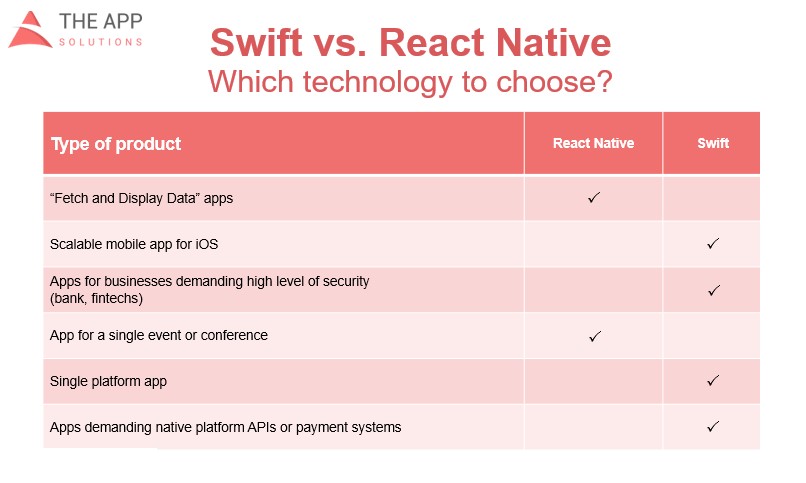
Folio3 is known to bring a lean startup approach to deliver innovative services. Whether you are a startup or a large-scale enterprise, Folio3 can cater to all your requirements while finding the uniqueness in your existing services and products and help you understand the chances of improvement, innovation, and growth. It can provide you with a one of a kind mobile solution for your business requirements.
Which is better by performance? React Native or Swift?
For the evaluation of performances of both developers, React Native and Swift, a case study had been done to decipher the better developer. Tests had been performed to compare the statistics and functions of both developers and the results were as follows:
Scrolling Down the List Multiple Times on both Swift and React Native simultaneously:
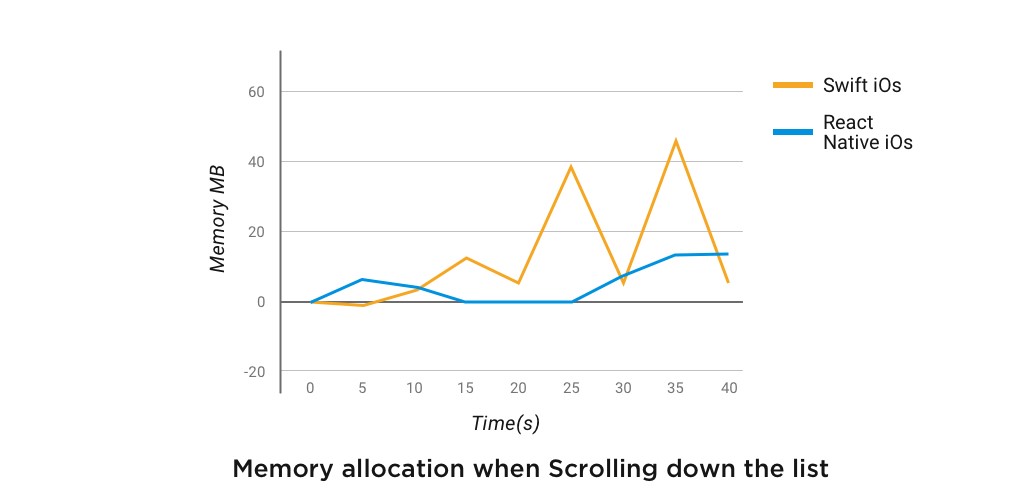
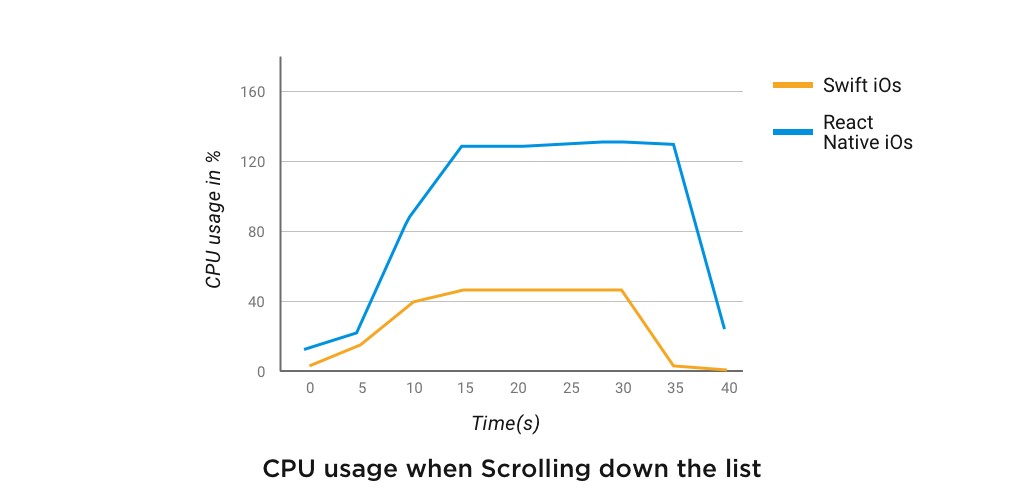
In regards to a Memory allocation of both Swift and React Native: Whilst scrolling down the list constantly, multiple times, it had been observed that the application developed with Swift had consumed about 0.65% more memory than React Native application.
Central Processing Unit usage: According to the test, the application that had been developed in React Native showed an average CPU usage and consumption of 85% and around 129% of peak Central Processing Unit usage. On the other hand, the application that had been developed in Swift showed an average Central Processing Unit usage of 27% and an allocation of 47% at peak CPU allocation.
Hence proven, in React Native Vs Swift performance comparisons, Swift emerged as the efficient developer of choice with better memory and central processing unit usage.
Test conducted to check memory allocation while Editing and Deleting Multiple tasks at a time:
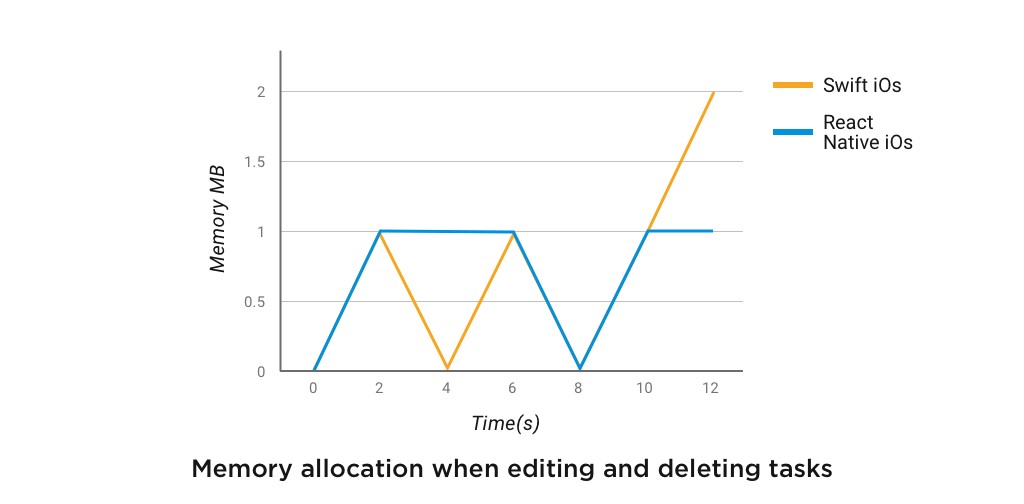
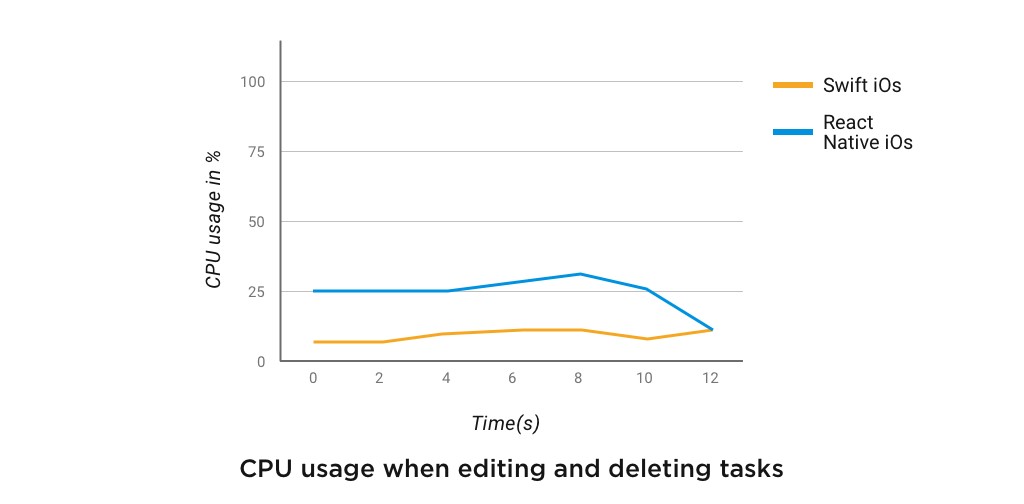
Memory Allocation – As seen in the graph above, there is no significant difference in React Native and the Swift developed application when multiple tasks had been added and deleted in the list.
Central Processing Unit consumption- The graphical representation presented above evidence shows that the React Native developed application consumes about 66% of average central processing unit usage while the Swift application only consumes a mere 10% of the average central processing unit usage.
Addition of new tasks in multiple attempts
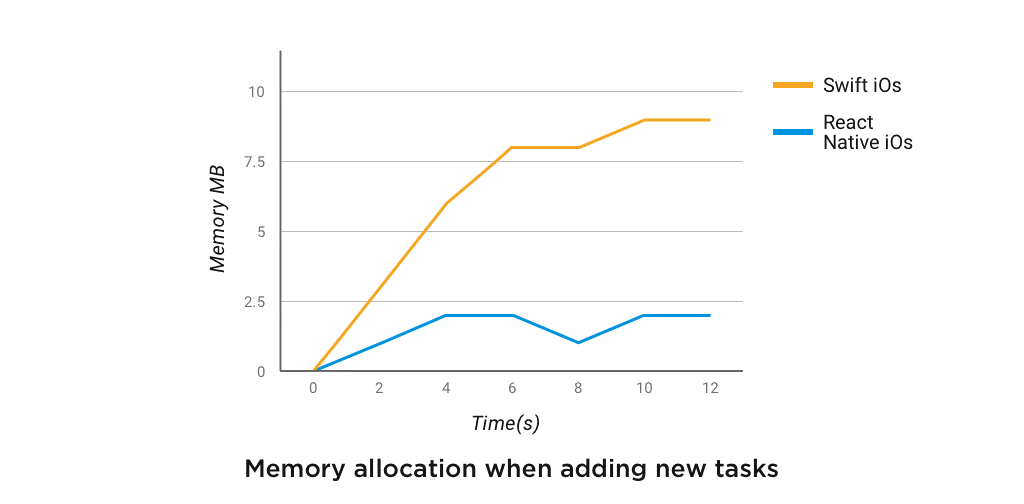
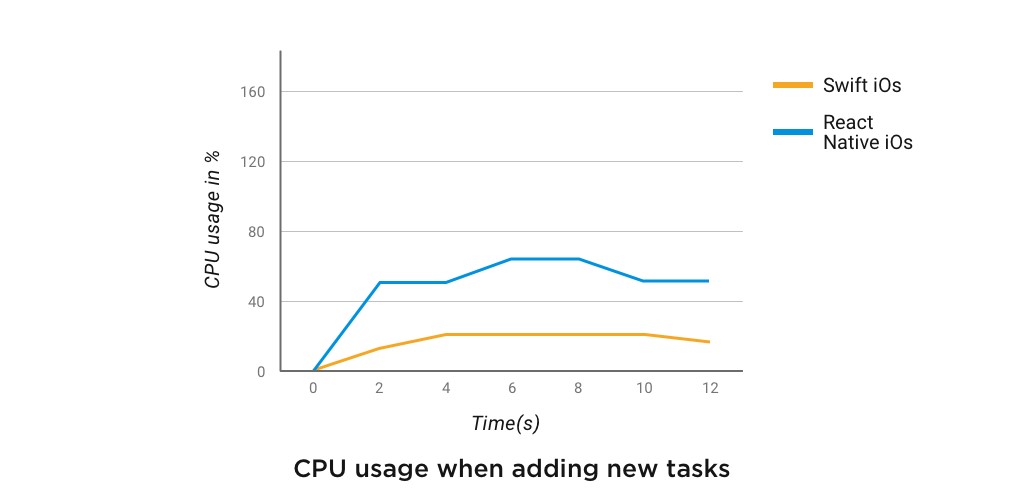
Memory allocation- React Native consumes more memory when the addition of new tasks multiple times had been conducted. While in case of swift,
Central Processing Unit Consumption with the Swift application showed an average of 14% CPU utilization while addition of multiple tasks to the list. On the other hand, React Native application had consumed 111% CPU allocation doing the same on an average.
Memory and CPU usage and allocation while scrolling up the list
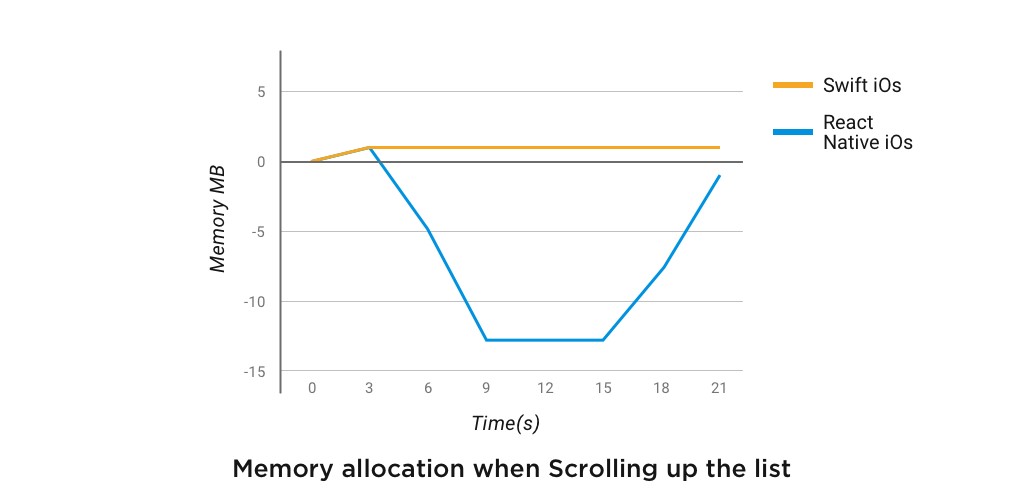
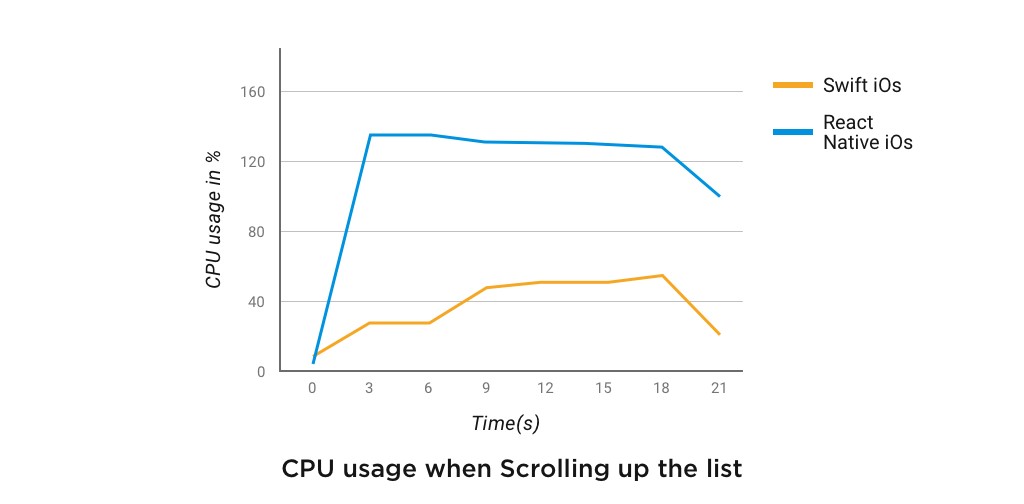
Memory Allocation: According to the graphical analysis presented above the memory allocation of the developer React Native and developer Swift applications while scrolling up the list in the app multiple times. As presented the graph for Swift application remains flat throughout the complete course of the scrolling process. On the other hand, the graph for React Native shows the high reach at the start, low towards the middle and then again towards the high reach in the end.
Central Processing Unit Usage: During the exercise of scrolling up multiple times, the Swift developer application showed an average of 35% CPU usage while the React Native developer application had utilized about 110% of CPU as an average.
Navigation back and forth from the main screen:
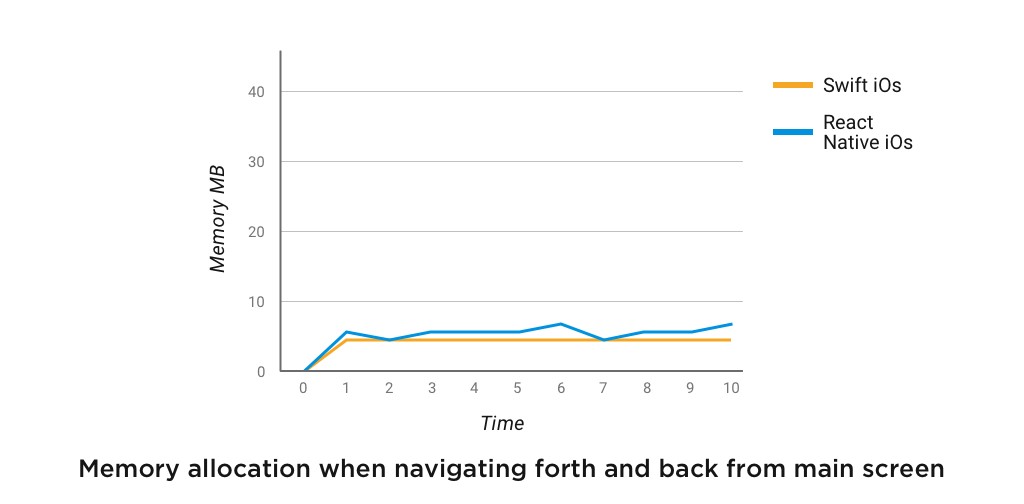
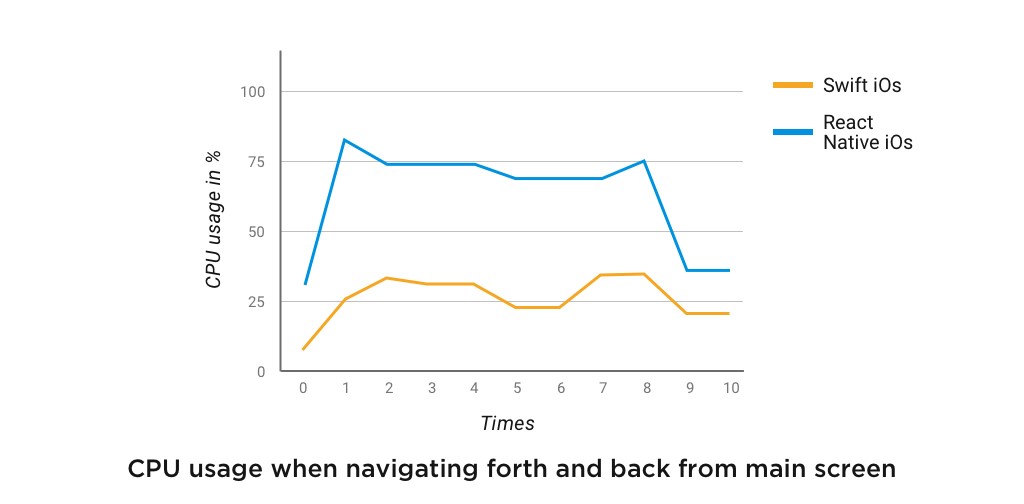
Memory allocation: The Memory allocation graph above showcases that both the Swift developer application and React Native developer application almost show similar memory allocation at a constant rate. As per observation an almost negligible difference between both the Swift developer and the React Native developer application in this case.
CPU Usage: While navigating back and forth from the main home screen to the to do list screen, it had been observed that the Swift developer application had utilized about 24% of CPU at an average while the React Native developer application had shown an average utilization of 62% CPU in this case.
Benchmarking application size and Time of advancement for React Native and Swift. An application size comparison of the to do list application which was designed for both the React Native Developer and the Swift developer, respectively are as follows:

As seen in the picture above, the respective size of the application developed in React Native is 20.2 MB whereas the size of the application by the Swift developer is 16.2 MB. This result clearly implies that for application size, Swift will outperform React Native.
While development of the React Native application takes a brief time period of approximately 1.5 months On the other hand, the development of the Swift application takes approximately 2 months for the completion.
Why would I build an app in React Native instead of using Swift?
React Native is helpful and much more convenient to code and gives a native like feel to the mobile application. It is likewise conceivable to get to all platform highlights and features to the fullest by utilizing and making use of React Native. The use of Java Script makes rendering simpler across server and customer browsers. It is not weighed down with side effects of a hybrid HTML5 application. It intelligently and interactively creates the UI, because of the availability of huge libraries, tools, and many ready hand solutions. Overall, in general this speeds up the process of development.
Other Features That Make React Native Desirable:
React Native (RN) is open-source and is driven by a vast community. It can ease out programming on both iOS and Android platforms. RN architecture is well-tuned to mobile devices as it is based on the Graphics Processing Unit instead of the Central Processing Unit. It has the ‘live-reload’ feature that allows top react native app developers to see instant changes to code at runtime. The modular and interactive interface makes it easy to create flexible applications, thus makes the task of test engineers easy, and builds appropriate testing scenarios. It makes use of predictive API that predicts app UI, a highly responsive interface. React Native allows code reuse (write once, use anywhere paradigm) and helps save time, effort and cost subsequently.
Major React Native Applications in 2020
- Facebook- A social media and social networking website
- Instagram- An application based on photograph sharing and live picture and video stories.
- Skype- One of the first video calling and messaging applications created.
- Walmart- An application designed for online shopping and shipping.
- Tesla- Leading vehicle communication application.
- Airbnb- A Hotel Booking and surfing application designed for travelers.
- Sound Cloud Pulse- An online music application.
- Bloomberg News etc., Gyroscope, Myntra, UberEats, Discovery VR, Townske, Wix and Delivery.com etc.
Conclusion:
Both Swift and React Native are strong developers for application development. Nonetheless, the decision between Swift or React Native application relies upon the type of project:
Go for Swift if you:
- Need to make an iOS-only application
- Build up a complex application which utilizes a large part of platform-specific codes.
- Need to keep up the application over an extensive stretch and for a long period of time
- Need an application to oversee things and manage things like memory footprints, or the application requires lots of interactions with the UI, similar to games.
- Need your application to be compatible with the latest iOS features and updates.
Go for React Native in case:
- You have to assemble an application for both iOS and Android with a small team and have limited time and resources.
- Your project demands quick structure time, hot reloading, and live reloading features.
- Your application will appear to be identical for both Android and iOS.
By picking the correct platform for your iOS applications, you will reduce development costs, increment application efficiency and improve continuous application support.
